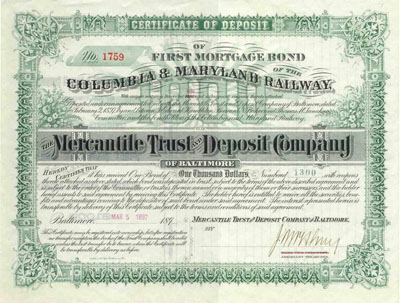Certificates of deposit
Certificates of deposit are somewhat and often inaccurately described by amateur sellers. In practice, certificates of deposit are receipts printed by trust companies and occasionally savings banks. They always display names of railroad companies, but they were NOT issued by railroad companies themselves. They are usually about the same size as stock certificate, printed in horizontal formats, usually with engraved borders, but seldom vignettes. Naming of certificates of deposit depended on the issuer with over thirty different variations recorded in this database. Their most typical titled include:
- Certificate of Deposit
- Deposit Receipt
- Negotiable Certificate
- Receipt for Deposit of Stock
- Receipt for Deposit of Bonds
Most examples display 15 to 30 lines of text explaining their purposes, although some seem a bit mysterious today. Chances are, the certificates would have been preceded by letters or pamphlets sent to investors explaining more fully their underlying rationale and purposes. All certificates of deposit seen so far seem to fall into two categories.

Typical certificates of deposit
The most common reason for their existence was an effort by companies, receivers or groups of interested security holders to gather in one place as many outstanding original and valid certificates as possible for some purpose. Oftentimes, groups of bondholders would band together because companies were missing interest payments. They would ask other bondholders to deposit their bonds with a trustee in order to gain sufficient bargaining power to force recognition by recalcitrant boards of directors. In return for the bonds deposited, those "depositaries" would give bondholders formal certificates of deposit attesting to the voluntary and temporary surrender of their securities. In extreme cases (which were usually occasioned by too many missed payments), bondholder groups forced companies into receivership or bankruptcy in attempts to recover some or all of their original investments.
In similar manners, stock certificates were gathered in similar manners, although the reasons for their collection are seldom as clear as with bonds. It appears many certificates of deposit were used when consolidating two of more companies into one larger one.
Whenever two or more companies were merged or consolidated, share prices were seldom equal. Moreover, share prices were always changing. By trading certificates of deposit for official shares, trust companies could amass outstanding shares in a single place. At the moment of consolidation, trustees could handle the disbursal of shares of the new company at agreed-upon ratios without argument or unfair practices. For instance shareholders of one company might receive one new share for one old share, while shareholders of a weaker company might receive one new share for every two and a half old shares.

Whether certificates of deposit were for traded stocks or bonds, collectors can sometimes get an idea of their purposes if certificate dates approximate a consolidation, receivership, or bankruptcy. Beyond that, it is usually impossible to go much deeper into the exact purposes of these documents without examining corporate records. That can be challenging at best. Explanations can sometimes be found in newspapers and industry publications
While certificates of deposit were neither stocks nor bonds, they represented genuine securities that owners had deposited with trustees. Consequently, they had value and were bought and sold like the securities themselves. They were, in fact, negotiable. (Images courtesy of Coleman Leifer and William Knadler.)
Uncommon certificates of deposit
A few CDs are known labeled as "certificate of deposit for coupons." The phrasing implies that companies had gone too long without paying interest. By collecting unpaid coupons, bondholder groups could force companies into reorganization or bankruptcy. In some cases, companies issued new "certificates of indebtedness" which spread repayments over several years in efforts to avert full-blown bankruptcies and the possibilities of being taken over by competitors.
Another rarely-seen type of certificate of deposit represented the collection of state aid bonds. That, in turn, suggests states were not paying their debts, an occurrence all too common during Reconstruction following the Civil War.
Easier to understand, although no more common, are "reorganization certificates" and "reorganization committee certificates." Their names clearly indicate that certificates from troubled companies were being collected in order to direct the formation of hopefully more successful new companies. Another rare type is titled "Stockholders' Reconstruction Certificate."
Voting trust certificates were issued by trustees in exchange for regular capital, common or preferred stock certificates. This project normally catalogs voting trust certificates with regular stock certificates. Some, however, more closely resemble certificates of deposit in that they clearly state the process of switching from formal stock certificates to trust certificates. Those types usually state that formal trust certificates were to be issued at some later time. In other words, their nature as temporary receipts is more obvious..
Please note: A small number of certificates of deposit are known with handwritten railroad company names. Certificates of such nature were commonly pre-printed generic forms created by ordinary print shops. Many of those documents are scarce and historic. However, they were designed to have been used by ANY type of company, not just railroads. Moreover, their purposes were more mundane such as holding securities for estates until all debts and legal disputes had been settled. Certificates of Deposit of that type are considered off-topic unless they show pre-printed company names.